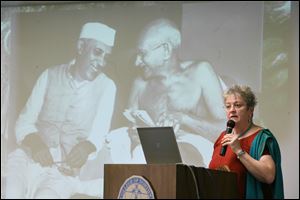
India a potpourri of religions, local nun says
3/31/2012
Sister Karen Elliott, a Mercy nun and theologian, describes to a group at Mercy College her observations from a recent trip to India.
Hinduism is the dominant religion in India, but many other religious traditions come together in a medley that reflects the diversity of the subcontinent, said Sister Karen Elliott, a theologian and professor at Mercy College.
In a talk this week to about 200 people at Mercy, where she is associate professor and chairman of the religious studies department, Sister Karen discussed observations from her three-week visit to India in December and January.
"It is a real potpourri of religions, not the separation as in the United States," she said.
Syncretism, or the merging of symbols, practices, and cultures, is everywhere, Sister Karen said.
As examples, she showed a photograph that she took of a painting of Jesus in a lotus position, a meditative posture usually associated with Hinduism, and of a Catholic tabernacle with the Holy Eucharist displayed in the middle of a painted mandala, a circular geometric pattern found in Buddhism.
India is a teeming nation of 1.2 billion, more than three times as many people as in the United States. Eighty one percent of Indians are Hindus; 27 million or 2.3 percent are Christians, 13 percent are Muslim, and 2 percent are Sikhs, according to the CIA World Factbook.
Sister Karen, a member of the Sisters of the Precious Blood religious order, called India a land of contrasts where colors, food, flora, and fauna create "sensory overload" for foreign visitors.
She attended the ordination of a Catholic priest, the nephew of the Rev. Raphael Karekatt, a Precious Blood priest who teaches during the summers at Mercy College, and was struck by the differences from U.S. ordinations.
The ordinand's photograph was displayed on a poster as large as a highway billboard, for example, the altar was decorated with a rainbow of flowers, and the ordinand was escorted to the ceremony in a motorcade that would rival a Hollywood celebrity's. The ceremonies are much less flashy in the United States, she said.
Another thing that caught the nun's eye was how the person to be ordained stood in the audience with family members until being called forward by the bishop, who then asked the father and mother for their permission to ordain him. The ordinand's parents then prayed a blessing for their son, Sister Karen said. "It was very family-oriented," she said.
The service lasted four hours, and those in attendance stood, kneeled, and sat on a marble floor.
Afterward, the Indian bishop asked Sister Karen if she understood the local language, Malayalam. When she said no, the bishop commented that it was unfortunate "you didn't understand anything" during the ordination ceremony.
"I told him I am a nun and a theologian, and I understood everything except the words," she said. "He replied, ‘Good answer.'?"
Sister Karen, who visted Kerala state in southern India and Mumbai on India's west-central coast, stayed for part of her visit at a convent of the Sisters of Charity of St. Anne in Mumbai, where she taught college-age students. She noted that Indians have "great respect for teachers and a reverence for education," and that most of the nuns she met spoke between five and nine languages.
Her students had all read Sister Karen's new book, Women in Ministry and the Writings of Paul, cover to cover in just a few days.
"When they gave their presentations on the book, it brought me to tears: They understood the material on every level," Sister Karen said.
In addition to India's religious differences, the nun offered observations on India's cultural diversity and the urban lifestyle of Mumbai, a city of 12 million. Some highways consisted of eight lanes of traffic in each direction with cars, auto rickshaws, ox carts, and elephants all moving in controlled chaos.